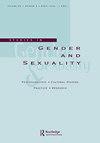多里安·格雷的《变态的肖像和镜子》
Q3 Social Sciences
引用次数: 1
摘要
《道林·格雷的画像》将我们带入一个自恋的迷宫,其中充斥着及物主义和想象混乱的现象,如拉康对镜像阶段的描述。倒转到对立面和转身的现象在故事中也很常见,造成了无尽的旋转,给人一种矛盾的印象;这些都是一种扭曲的运作方式的迹象,在这种方式中,被卷入这个自恋世界的角色,有时会在“永远无法抗拒的孩子”的幻觉中获得安慰,有时会发现自己被驱逐出那个位置,降级为“永远永远感到羞耻、羞辱和无效的孩子”。这种过度发展的镜面自我根植于一种理想化的、共犯的母性凝视的“镜像功能”,然而,这种凝视与一种可怕的母性凝视交替出现,视觉的暴力在这里与一种致命的母性凝视的爆发联系在一起。本文章由计算机程序翻译,如有差异,请以英文原文为准。
Dorian Gray’s Perverted Portraits and Mirrors
ABSTRACT Reading The Picture of Dorian Gray draws us into a narcissistic maze rife with phenomena of transitivism and imaginary confusion, such as Lacan described with respect to the mirror stage. Phenomena of reversal into the opposite and turning around are also very present in the story, causing an endless rotation of places, giving a paradoxical impression; these are indications of a perverse way of functioning in which the characters, swept up into this narcissistic universe, will sometimes take comfort in the illusion of being in the position of the “always-and-forever-irresistible-child,” and sometimes find themselves banished from that position and relegated to that of the “child-who-is-always-and-forever-shamed, humiliated, nullified.” This kind of overdeveloped specular ego is rooted in the “mirror function” of an idealized and complicit maternal gaze, which nevertheless alternates with a horrifying maternal gaze, the violence of sight being linked here with the eruption of a deadly maternal gaze.
求助全文
通过发布文献求助,成功后即可免费获取论文全文。
去求助
来源期刊

Studies in Gender and Sexuality
Social Sciences-Gender Studies
CiteScore
0.80
自引率
0.00%
发文量
15
期刊介绍:
Beginning in the final two decades of the 20th century, the study of gender and sexuality has been revived from a variety of directions: the traditions of feminist scholarship, postclassical and postmodern psychoanalytic theory, developmental research, and cultural studies have all contributed to renewed fascination with those powerfully formative aspects of subjectivity that fall within the rubric of "gender" and "sexuality." Clinicians, for their part, have returned to gender and sexuality with heightened sensitivity to the role of these constructs in the treatment situation, including the richly variegated ways in which assumptions about gender and sexuality enter into our understandings of "normality" and "pathology."
 求助内容:
求助内容: 应助结果提醒方式:
应助结果提醒方式:


